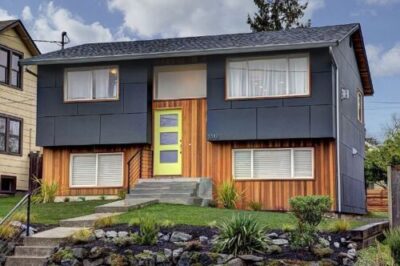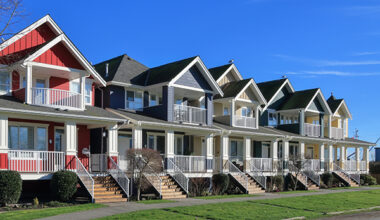A bi-level house, sometimes known as a raised ranch, was a prominent architectural firm in the Midwest and Northeast of the United States in the 1950s and 1960s. When looking for real estate, a bi-level home is a likely alternative depending on your market. While these houses can be ideal for specific buyers or renters, they are a bit of a niche market that should be considered when looking for an investment property. Read on to find out if a bi-level property would benefit or harm you, whether you’re renting or flipping.
What is a Bi-level House?
A bi-level house is simply a one-story home that has been raised to the point where the basement level is partially above ground, allowing for natural light and making it an ideal location for living quarters. Basements in such homes are usually always turned into comfortable family, gaming, or playrooms, but they can be done later because the vital components of the home—bedrooms, bathrooms, and kitchens—are on the top level.
Due to a drive-under garage and utilities, the square footage of the lower floor is typically less than that of the main floor. Bi-level home entries are also distinct in that there is a staircase leading up to the front door, followed by a little landing just inside that lies between the two floors, linking to two short staircases that run up and down. This style, sometimes known as a raised ranch, was popular in the 1950s and continues to be popular with families since the children can play downstairs without disturbing the rest of the house.
Bi-Level vs. Split Level
Most people believe that a split-level home and a bi-level home are the same sorts of structure. Bi-level houses feature two levels that are connected by a common entryway. Split-level homes, on the other hand, feature three distinct floors that are separated by a short flight of stairs. When the two are compared, significant advantages and disadvantages of each emerge:
- Split-level homes provide greater privacy and separate living areas than bi-level homes.
- The entrance to a bi-level is usually positioned between the two levels.
- A split home is distinguished by a bank of windows that is lower on one side than the other, as in a partially underground basement-style family or amusement area.
- Bi-level homes were predominantly constructed in the 1970s, but split-level homes were constructed as early as the 1950s.
- Neither form of the house is often constructed nowadays.
- Split-level homes contain the common living areas (kitchen, dining, and living rooms) on the main level, with bedrooms on the level above and a family room, rec room, spare bedroom, or storage area below.
- The majority of bi-level homes are modified Ranch-style homes, whereas split-levels appear in a variety of architectural styles.
- Both home designs take advantage of the lot area by constructing additional houses vertically rather than horizontally. Split-level homes often have more rooms than bi-levels, but may or may not have more square footage, depending on the floor plan.
The Primary Differences Between a Split-Level House and a Bi-Level House
These are the primary distinctions between a split-level house and a bi-level house. These are fairly common and can be found in nearly every bi-level or split-level house.
#1. Half Stairs
A lot of the time, split-level homes have half-stairs that go to the various levels of the house. Assume you step onto the landing of a standard set of stairs. One part of the steps ascend, while the other descends.
This is the most common configuration for a bi-level home, though it can also be seen in split-level homes. The distinction is that split-level homes have numerous stories, but bi-level dwellings have only one story that is divided.
#2. Basements with Low Ceilings
Basements in split-level homes are typically half-exposed, although they are always used properly. The basement is frequently used for anything other than storage. The basement is well-lit, and it is used on a daily basis.
Egress windows are being placed on basements to make them safer and to give a decent escape route in the event of a fire or other threat. If you have a basement, egress windows are necessary for many places.
#3. Various Materials
The majority of split-level homes are constructed from a variety of materials. Stone and wood are frequently combined, with one level composed of stone and the other of wood. This is one topic that a lot of people are interested in.
#4. Utilization of Every Square Foot
Split-level homes were originally intended to make the most of every square inch of a compact house on a small lot. As a result, they are designed to have limited open floor space while being open-concept at times.
Even when the levels are separated by walls, architects make the most of the available space by squeezing each room into whatever space they are allowed. Even living quarters or an office are housed in the basement.
The Secondary Differences Between a Split-Level and a Bi-Level Home
These are the secondary distinctions between a split-level house and a bi-level house. You will see that they are consistent, but they are most noticeable when the above confirms that you are looking at either a split-level house or a bi-level house.
#1. Bay Windows
Though not all split-level houses have bay windows, they are fairly prevalent. The magnificent windows, which frequently include a window seat, are very common. They have additional unusual windows when they don’t have bay windows.
To provide dimension to the Brady Bunch house, it had clerestory windows and several windows at different levels. Despite the lack of bay windows, the clerestory windows were the real stars of the Brady Bunch House.
#2. Garages that are Connected
There are numerous styles of garages, but because split-level houses typically have smaller lots, a connected garage is required. The garage is usually lower than the house, albeit not as low as a basement.
This is also prevalent in bi-level homes, where the garage is significantly lower than the house while being on the same story. There is only a little step down into the garage, which is typical of bi-level homes.
#3. Low Pitch Roofs
Roof slopes on split-level dwellings are usually always low. It is a flat roof if it is not low. Flat roof dwellings have issues, particularly with drainage, but a low-pitched roof solves those issues.
The low pitch of the roof was popular when split-level dwellings were prevalent. Despite the fact that the houses themselves are one of the least popular kinds of residences in America, it nonetheless looks pretty current today.
Is it fashionable to live in a two-storey house?
The bi-level design gained popularity in the 1950s but swiftly fell out of favor with builders by the 1970s. They are still available as a custom-home build request today, though not as frequently as they formerly were.
Bi-level homes are still a great alternative for families today since youngsters can play downstairs without disrupting the main living area above. Consider it a cross between the ranch and colonial styles. The ranch house has one storey, while the colonial has two above-ground levels. They can be less expensive to build than other types of dwellings and provide a big amount of living space in a tiny area.
What effect does it have on the value of a home?
A bi-level can be quite appealing to certain purchasers, generally families with young children, but when contrasted to the open floor plan of a modern home, they can appear very jagged and broken up, with all the stairs and several floors. They can also be tough to remodel and update due to the impossibility to change up the split entry, which is a split-level home’s defining feature. This can make them more difficult to rent or sell, resulting in a lower price point.
However, this does not preclude you from selling them and making a profit. Positively emphasizing attributes can make a significant effect. You can highlight the different living rooms as a method to assure greater peace and quiet, the convenience of having an attached garage so the kids can get out of the car and head right to the playroom, or the extra windows on the lower level as an inviting sunroom. Simply know who you’re promoting and tailor your descriptions accordingly.
A bi-level home can be a fantastic way to squeeze a larger square-foot home into a smaller or steep property. These houses are especially suitable for families. When making an offer, take advantage of the normally longer days on the market so that the house can readily cash flow for you once rented or flipped.
Remodeling a Bi-level House
There are a few things you may do to remodel your bi-level house into a standard house and increase its market worth. These items can change a bi-level house into a modern-day house with a unique twist.
#1. Remove the Overhang
The first thing you should do is address the weird overhang on the front. They are almost always found in bi-level houses. The best approach to accomplish this is to construct beneath them and then demolish the prior load-bearing walls.
It is critical to construct new load-bearing walls before demolishing the old ones. If you don’t, your entire house may collapse, leaving you with a mess to clean up at best. So seek assistance with the load-bearing qualities.
#2. Construct One Side
Because most bi-level homes have various levels, building one side up to meet the other might be beneficial. Even if one side is a garage, it can help to ensure that the roofs on both sides are the same to make the house appear more typical.
#3. Make a New Entrance
If the split-level or bi-level home only has one entrance, consider creating a standard entrance that leads into the living room or kitchen. Make it at ground level, as this is what the majority of people prefer in their homes.
#4. Refresh the decor
Finally, the most critical step is to modernize the décor. This includes paint, drywall, siding, and anything else that is outdated. Bringing a home into the twenty-first century is the finest method to sell it. This is an issue with bi-levels.
Because most bi-level homes were built in the 1970s, this can be difficult. Engage the services of a specialist to assist you in locating anything that may jeopardize the house’s potential to sell. Take care of those items, and you’ll get your money back when you sell them.
Keep in mind that mid-century modern is and has been popular for many years if you want to work with what you have. So take that house and make it look like a mid-century modern home by emphasizing the best parts of the time.
What Is A Bi-Level Floor Plan?
Bi-level home plans are raised one-story house designs with a lower level of living space added to the ground floor. They are less expensive to build and are sometimes referred to as a raised ranch or split entry house plan.
Bi-Level House FAQs
What is considered a bi-level home?
A bi-level house design will have one level that is partially underground but elevated enough to allow natural light to enter the finished basement level, which serves as a family area, through windows. Because of the height, you will have to take several steps up to the front entrance and there will be no genuine ground level.
Are bi levels cheaper to build?
Bi-level homes are typically more expensive to build since they feature two full levels with more square footage than split-level homes with more rooms but smaller sizes.
Are bi levels hard to sell?
While some homeowners love split-level houses, they might be unappealing to others, making them difficult to sell. Too many steps, inadequate natural light, a choppy floor layout, and a lack of curb appeal are some of the factors that may make a split-level house difficult to sell.






